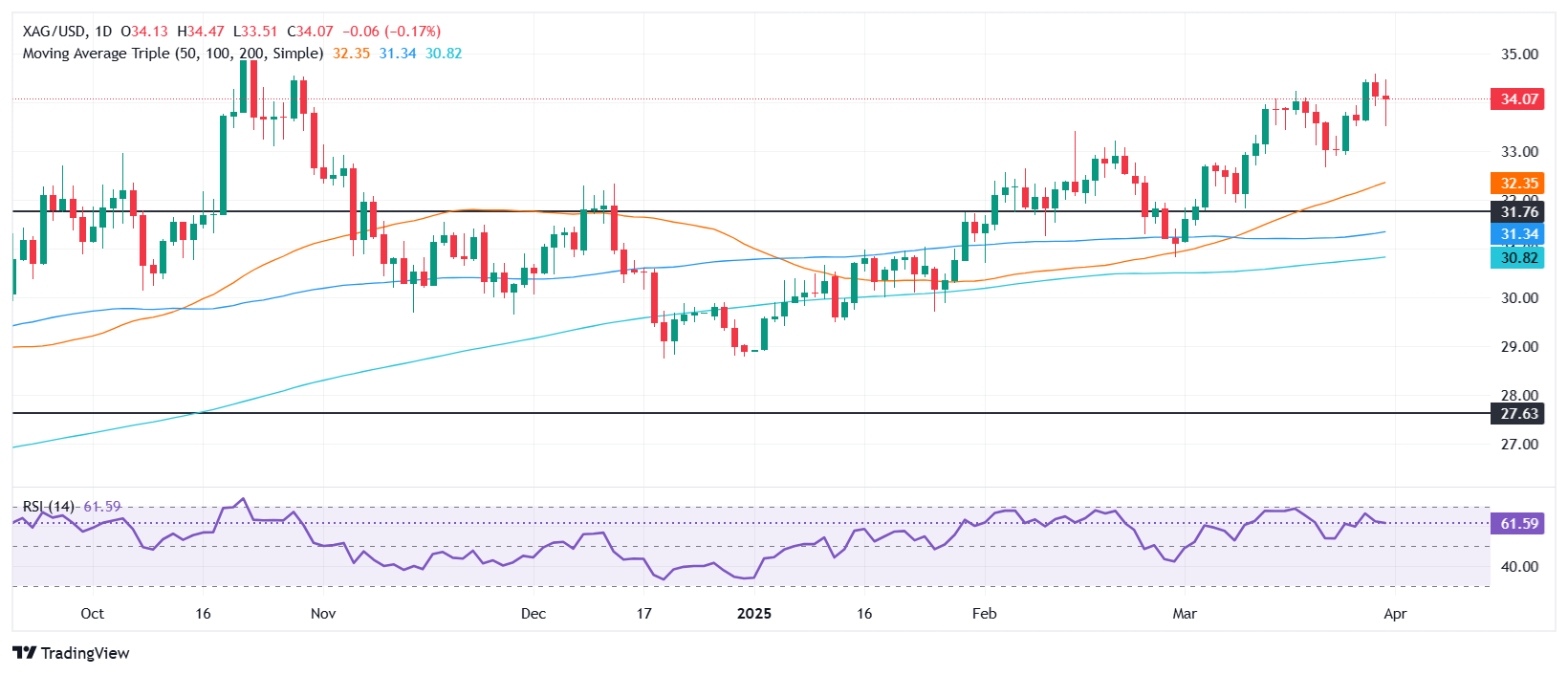Silver Price Forecast: XAG/USD holds above $34 despite falling
- Silver prints a ‘high wave candle,’ signaling market indecision after 5% rally over four sessions.
- A close above $34 keeps bullish momentum intact; targets lie at $34.58 YTD high and $35.40 October 2012 peak.
- Break below $34 may trigger correction toward $33.51 support, with $33.00 as next bearish target.
Silver price falls slightly after hitting a daily high of $34.46, trading at $34.02 amid a strong US Dollar and falling US Treasury yields.
Market mood improved slightly, but traders are awaiting April 2, US Liberation Day, on which US President Donald Trump is expected to unveil tariffs. Speculation suggests that the US will apply 20% universal tariffs.
XAG/USD Price Forecast: Technical outlook
Silver remains upward biased, despite retreating somewhat as a ‘high wave candle’ forms. After climbing over 5% in the last four days, indecision keeps buyers and sellers from opening fresh aggressive bets, as they could be awaiting the closing price.
If XAG/USD closes above $34, this could be bullish and pave the way for further upside. The first resistance will be the year-to-date (YTD) high of $34.58. On further strength, the next ceiling level would be $35.00, followed by the October 2012 peak at $35.40.
Conversely, if XAG/USD falls below $34.00, the first support will be the March 31 low of $33.51, followed by the $33.00 figure.
XAG/USD Price Chart – Daily

Silver FAQs
Silver is a precious metal highly traded among investors. It has been historically used as a store of value and a medium of exchange. Although less popular than Gold, traders may turn to Silver to diversify their investment portfolio, for its intrinsic value or as a potential hedge during high-inflation periods. Investors can buy physical Silver, in coins or in bars, or trade it through vehicles such as Exchange Traded Funds, which track its price on international markets.
Silver prices can move due to a wide range of factors. Geopolitical instability or fears of a deep recession can make Silver price escalate due to its safe-haven status, although to a lesser extent than Gold's. As a yieldless asset, Silver tends to rise with lower interest rates. Its moves also depend on how the US Dollar (USD) behaves as the asset is priced in dollars (XAG/USD). A strong Dollar tends to keep the price of Silver at bay, whereas a weaker Dollar is likely to propel prices up. Other factors such as investment demand, mining supply – Silver is much more abundant than Gold – and recycling rates can also affect prices.
Silver is widely used in industry, particularly in sectors such as electronics or solar energy, as it has one of the highest electric conductivity of all metals – more than Copper and Gold. A surge in demand can increase prices, while a decline tends to lower them. Dynamics in the US, Chinese and Indian economies can also contribute to price swings: for the US and particularly China, their big industrial sectors use Silver in various processes; in India, consumers’ demand for the precious metal for jewellery also plays a key role in setting prices.
Silver prices tend to follow Gold's moves. When Gold prices rise, Silver typically follows suit, as their status as safe-haven assets is similar. The Gold/Silver ratio, which shows the number of ounces of Silver needed to equal the value of one ounce of Gold, may help to determine the relative valuation between both metals. Some investors may consider a high ratio as an indicator that Silver is undervalued, or Gold is overvalued. On the contrary, a low ratio might suggest that Gold is undervalued relative to Silver.

